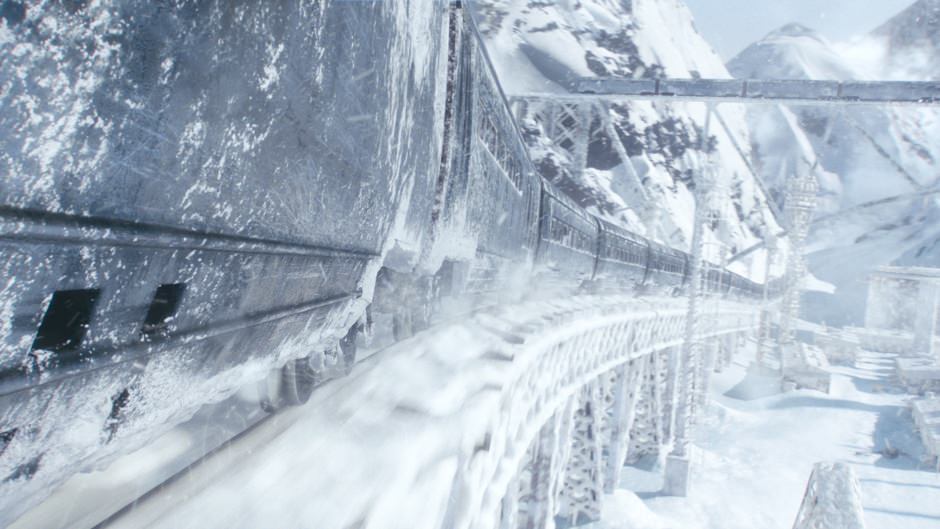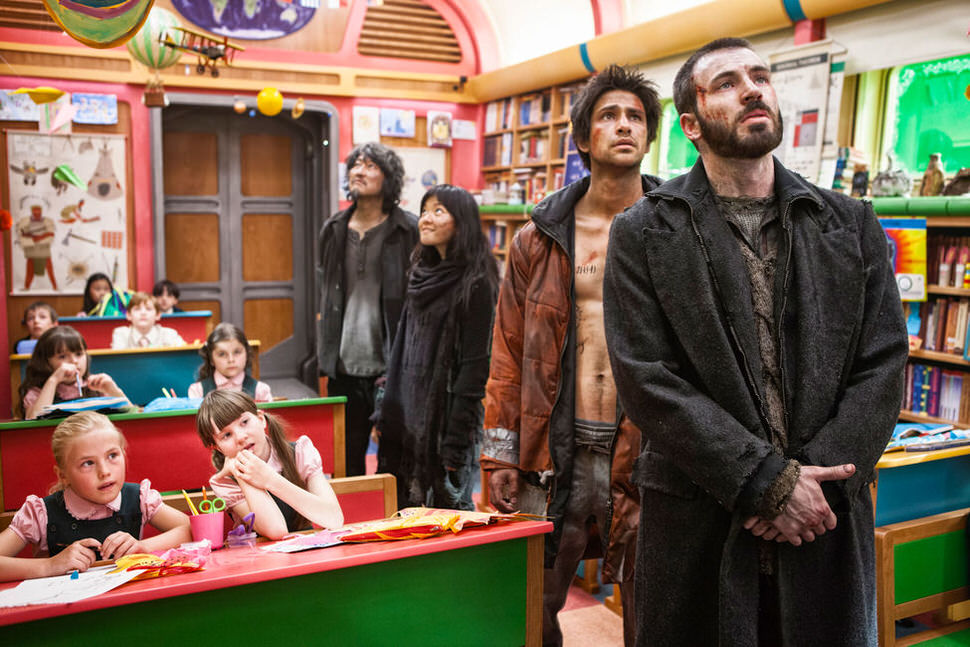Bong Joon Ho’s Snowpiercer is a madcap addition to the comic-book-derived movies that have dominated cinematic summer fare for much of the twenty-first century. At once streamlined and ramshackle, it doesn’t have a plot so much as a premise—or rather, a ruling metaphor.
Snowpiercer is set some decades in the future, after a misguided attempt to reverse global warming has instead precipitated a new ice age. Virtually the entire film takes place on a moving train that, endlessly traversing the globe, carries the last vestige of life on a frozen earth. Order is rigidly enforced. A tiny fraction of haves occupy the luxury cars up front; the hapless 99 percent are packed into rear cars and looking to redress their situation.
Rampant inequality is the film’s narrative motor. Human interest is negligible and psychology is irrelevant. The claustrophobic, forcibly focused tunnel vision suggests the situation of the doomed sewer-trapped partisans in Polish director Andrzej Wajda’s Kanal (1956), a film about the Warsaw uprising; the continuous trajectory is reminiscent of David Cronenberg’s Cosmopolis (2012), set almost entirely in a limo crawling through midtown Manhattan traffic.
The spectacle of class warfare aboard a 1,001-carriage super train makes for the most overtly leftwing pop movie in the eight years since V for Vendetta brandished the black flag of anarchy as the only recourse in a media-driven police state. Snowpiercer has enjoyed great success abroad, in part because its political program is couched as an action film. In fact, you might call the movie—freely adapted by a South Korean filmmaker from a French graphic novel, shot mainly in the Czech Republic with a largely Anglo-American cast, and intended for the largest possible international audience, China included—an example of globalism, or perhaps anti-globalist globalism, in action. (Apparently disconcerted by Snowpiercer’s two-fisted anti-authoritarian stance, the Weinstein Company—which acquired the movie on the basis on an early script—first attempted to recut it, and failing that has given it a marginal, “art house” release.)
The movie’s principals are an appropriately motley lot. Chris Evans, the eponymous star of Captain America and a presence as generic as his name, is the nominal protagonist, an angry young “natural leader” from the back of the train. John Hurt hams it up as his wizened guru, and Jamie Bell, the original Billy Elliot, is his young sidekick. Korean actor Song Kang-ho appears as a drug-addicted scientific genius who is bribed to join the revolt; the ingénue Ko Ah-sung plays his daughter, as she did in Bong’s The Host (2006). Oscar-winner Octavia Spenser, part of The Help (2011), is the aggrieved mother whose loss provides the spark that ignites the revolt.
The villains are more vividly cartoonish. Ed Harris, the train’s creator and engineer, pads around in a silk robe and pajamas, as proprietorial as Hugh Hefner in the Playboy Mansion. Cast as his spokeswoman, Tilda Swinton is a walking nightmare with a thick Yorkshire accent and prosthetic bad teeth, handling every crisis with the shrill Thatcherite mantra “All passengers in their place!” As an implacable enforcer, Romanian actor Vlad Ivanov, who played the abortionist in 4 Months, 3 Weeks and 2 Days (2007) and an only slightly less sinister cop in Police, Adjective (2009), adds to the international bouillabaisse.
Bong is a forty-five-year-old master of mix-and-match cinema who has incorporated manga elements into his previous movies. His hard-to-classify genre films include two quite different horror comedies, The Host, in which a Godzilla-like monster rises from the toxic sludge of Seoul’s polluted Cheonggyecheon river, and Mother (2009), a Hitchcockian tale of a small-town sex crime involving a local madwoman and her village-idiot son. Each of these conjures a primal force, whether the destructive power of ecological disaster or the amoral drive of a deranged maternal instinct. Snowpiercer doesn’t dramatize a force so much as it embodies one.
The director discovered Le Transperceneige (1982), the comic by Jacques Lob and Jean-Marc Rochette on which Snowpiercer is based, in a used bookstore in Seoul. Bong says that he was transfixed and, as if to demonstrate the nineteenth-century stock phrase that railway travel produced the “annihilation of time and space,” read the entire novel then and there. But in adapting Le Transperceneige, which is undistinguished in every aspect save its concept, Bong and his American cowriter Kelly Masterson kept only the novel’s premise, freely embroidering it with new characters and incidents.
Much money has been spent. The movie is not quite a two-hour tracking shot but it might as well be—the interior of the carriages is the world. Bong’s cluttered, gadgety mise-en-scène is reminiscent of Terry Gilliam’s cult film Brazil, particularly once the proles break through into the forward cars—one is an aquarium, another is a greenhouse; there’s also a kindergarten, and a finally the inevitable orgiastic disco.
Advertisement
Perpetual movement was contrived by staging the film on a giant gyroscopic gimbal in Prague’s Barrandov Studio. Mediated by CGI imagery, the “exteriors” are restricted to rare shots of the train plowing through a majestic ice chasm and, in one visual or programming tour-de-force, an impressive car-to-car fire fight as the impossibly long, not quite ouroboric train rounds a curve.
The underclass uprising is brutal, with much hand-to-hand combat (as well as stabbings, gougings, and amputations) in confined, jolting spaces. Everyone is under pressure. As shortages are endemic, even bullets are “extinct.” At one point, someone smokes “the world’s last cigarette.”
A former student activist who has been associated with a succession of small leftwing parties, Bong is an anti-authoritarian populist with a strong sense of the absurd. Although he has been compared to Steven Spielberg in his use of genre conventions, he is temperamentally closer to less respectable American practitioners of wise-guy sociological shock schlock like Joe Dante, George Romero, and Larry Cohen. As with Romero’s Land of the Dead (2005), in which an even more implacable lumpen element—reproachful zombies—rises up against a degenerate one-percent, it’s impossible to miss Snowpiercer’s point.
The movie projects as outlandishly blunt a social metaphor as any movie since Fritz Lang’s 1927 Metropolis envisioned a futuristic New York wherein the workers lived and labored in a realm below the subway while their rulers cavorted in rooftop gardens higher than the Empire State Building. Seen today, Metropolis is a clearly hysterical, cautionary reaction to Eisenstein’s incendiary Battleship Potemkin–incited by a lascivious robot, the proles stupidly flood their home in their mindless revolt. Snowpiercer, by contrast, is a blatant rabble-rouser stoking the pleasure of underclass revenge, as the great unwashed storm the tsar’s palace.
Late in the movie, a discussion develops regarding free will and political expedience and the possibility of provocation, but Bong’s argument is entirely visceral. (Literalizing the notion of “body as capital,” he adds a backstory detailing conditions under which the proletariat is forced to dismember and devour itself in order to survive.) Are the People an irresistible force? Will their forward progress be stopped?
Watching Snowpiercer one cannot help but recall Marx’s italicized comment in The Class Struggles in France that “revolutions are the locomotives of history.” But a metaphor can only take you so far. What happens when the locomotive is trapped in an endless circle like a lab rat on a treadmill or, one of the many things that happens as events reach their tumultuous climax, the train runs off the rails?




